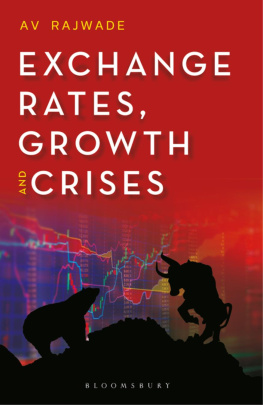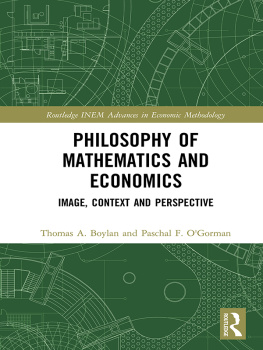Richard Bookstaber - The End of Theory: Financial Crises, the Failure of Economics, and the Sweep of Human Interaction
Here you can read online Richard Bookstaber - The End of Theory: Financial Crises, the Failure of Economics, and the Sweep of Human Interaction full text of the book (entire story) in english for free. Download pdf and epub, get meaning, cover and reviews about this ebook. City: Great Britain, year: 2017, publisher: Princeton University Press, genre: Romance novel. Description of the work, (preface) as well as reviews are available. Best literature library LitArk.com created for fans of good reading and offers a wide selection of genres:
Romance novel
Science fiction
Adventure
Detective
Science
History
Home and family
Prose
Art
Politics
Computer
Non-fiction
Religion
Business
Children
Humor
Choose a favorite category and find really read worthwhile books. Enjoy immersion in the world of imagination, feel the emotions of the characters or learn something new for yourself, make an fascinating discovery.
- Book:The End of Theory: Financial Crises, the Failure of Economics, and the Sweep of Human Interaction
- Author:
- Publisher:Princeton University Press
- Genre:
- Year:2017
- City:Great Britain
- Rating:3 / 5
- Favourites:Add to favourites
- Your mark:
- 60
- 1
- 2
- 3
- 4
- 5
The End of Theory: Financial Crises, the Failure of Economics, and the Sweep of Human Interaction: summary, description and annotation
We offer to read an annotation, description, summary or preface (depends on what the author of the book "The End of Theory: Financial Crises, the Failure of Economics, and the Sweep of Human Interaction" wrote himself). If you haven't found the necessary information about the book — write in the comments, we will try to find it.
Richard Bookstaber: author's other books
Who wrote The End of Theory: Financial Crises, the Failure of Economics, and the Sweep of Human Interaction? Find out the surname, the name of the author of the book and a list of all author's works by series.
The End of Theory: Financial Crises, the Failure of Economics, and the Sweep of Human Interaction — read online for free the complete book (whole text) full work
Below is the text of the book, divided by pages. System saving the place of the last page read, allows you to conveniently read the book "The End of Theory: Financial Crises, the Failure of Economics, and the Sweep of Human Interaction" online for free, without having to search again every time where you left off. Put a bookmark, and you can go to the page where you finished reading at any time.
Font size:
Interval:
Bookmark:
THE END OF THEORY
The End of Theory
Financial Crises, the Failure of Economics, and the Sweep of Human Interaction
Richard Bookstaber
PRINCETON UNIVERSITY PRESS
PRINCETON AND OXFORD
Copyright 2017 by Richard Bookstaber
Requests for permission to reproduce material from this work should be sent to Permissions, Princeton University Press
Published by Princeton University Press,
41 William Street, Princeton, New Jersey 08540
In the United Kingdom: Princeton University Press,
6 Oxford Street, Woodstock, Oxfordshire OX20 1TR
press.princeton.edu
All Rights Reserved
ISBN 978-0-691-16901-9
British Library Cataloging-in-Publication Data is available
This book has been composed in Adobe Text Pro and Gotham
Printed on acid-free paper.
Printed in the United States of America
10 9 8 7 6 5 4 3 2 1
In memory of my son,
Joseph Israel Bookstaber
CONTENTS
SECTION I
Introduction
Crises and Sunspots
During a visit to the London School of Economics as the 2008 financial crisis was reaching its climax, Queen Elizabeth asked the question that no doubt was on the minds of many of her subjects: Why did nobody see it coming? The response, at least by the University of Chicago economist Robert Lucas, was blunt: Economics could not give useful service for the 2008 crisis And so might we all.
Englands royal family is no stranger to financial crises, or to the evolution of economic thought that such crises have spawned. Our standard economic model, the neoclassical model, was forged in Victorianthe limitations in the current standard economic approach to financial crises, and what to do about them, by looking at the path Jevons took in mid-nineteenth-century England.
This economic revolution was driven by a technical one. The railroad was the disruptive technology. It reached into every
Railroads were also the source of repeated crises. Then as now, there was more capital chasing the dreams of the new down-cycle casualty was Jevonss father, who was an iron merchant.
In 1848, in the midst of this revolution and its cycle of crises, the great economist and intellectual John Stuart Mill published his Principles of Political Economy, a monument to the long and rich tradition of classical political economy of Adam Smith, Jean-Baptiste Say, Thomas Robert Malthus, and David Ricardo. With this publication,
But over those two decades, with a backdrop of labor unrest and a rising footprint of poverty, cracks began to emerge in the pillars of Mills theory. into more efficient large estates. The laborers were paid subsistence wages, while the economic benefit from the increased productivity was captured by those controlling the machinery, the capitalists.
For those whose success or luck of birth pushed them into the newly emerging business class, life was filled with promise and stability. Men would become gentlemen with country houses, providing
The Birth of Modern Economics
Industrial age economics moved away from Mill in two directions. The one traveled by Marx, based on historical analysis and with a focus on the human consequences of the dominance of capital, fomented revolution that would engulf the world. The other, based on mathematics, emulated the mechanics of the natural sciences while ignoring the human aspect completely, forming the foundation for todays standard economic model, that of neoclassical economics. This was the way pushed forward by William Stanley Jevons.
To say that the development of the neoclassical approach ignored the human aspect is to say that it was a product of its times. Arithmetic, writes the historian Eric Hobsbawm, was the fundamental
This formed the starting point of Jevonss Theory of Political Economy: a quantitative analysis of the feelings of pleasure and pain. Of the seven Benthamite circumstances associated with pleasure and pain, Jevons selected intensity and duration as the most fundamental dimensions of feeling. Clearly, every feeling must last some time, and while it lasts, it may be more
Jevons was
after five years in Australia, he returned to University College to study political economy, where he won a Ricardo scholarship and a gold medal for his master of arts.
He poured himself into his new focus of study, and by the following year had already discovered the idea of marginal utility. He wrote to his brother that in the last few months I have fortunately struck out what I have no doubt is the true theory of economy. One of the most important axioms is that as the quantity of any commodity, for instance plain food, which a man has to consume increases, so the utility or benefit from the last portion used decreases in degree. In another letter he expanded on this discovery, giving a succinct explanation of marginal theory and the implications of the relationship between profits and capital: The common law is that the demand and supply of labor and capital determine the division between wages and profits. But I shall show that the whole capital employed can only be paid for at the same rate as the last portion added; hence it is the increase of produce or advantage, which this last addition gives, that determines the interest of the whole.
Jevons wrote up his ideas
been foreshadowed. He found himself in the unfortunate position that the greater number of people think the theory nonsense, and do not understand it, and the rest discover that it is not new. Jevons gave up on the hope that he would be able to establish a first claim to the concepts, but took comfort that the theory has in fact been discovered 3 or 4 times over and must be true.
Blinded by Sunspots: Jevonss Quest for a Scientific Cause of Crises
Jevons not only brought mathematical rigor to the field but also was the first economist to focus on the sources of economic crises. He had personal reasons for this focus. Not only had his father suffered a failure during the railroad bubble while Jevons was still a boy, but others in his extended family had suffered through similar difficulties. And he was brought up in Unitarian circles where social inequities were a point of concern. He was socially aware, and would take walks though the poor and manufacturing districts of London to observe social costs up close.
Jevons viewed an understanding of crises as the key test of economics. He believed that if economics could not explain market crises and detect and exhibit driven. Without some observable natural phenomenon to serve as causal agent, commercial crises threatened to become uninterpretable, limiting the claim of economics to be a science.
Because Jevons patterned his economic methods after the scientific methods used for studying the natural world, he looked for a natural phenomenon as the anchor for his study of otherwise unexplainable crises. Thishad certainly been subject to them, most recently the 18451850 railway mania bubble, which, like all bubbles, did not end well.
Jevonss interest in sunspots was not mystical. He hypothesized that the success of harvests might be one of many
Jevons used a sunspot cycle that had been determined by earlier researchers to be 11.11 years. All that remained, then, was to show that the cycle for commercial crises followed a similar course. A simple attempt at matching the two came up short, but, convinced that this theoryattractive from the standpoint of bringing economics into the fold of the natural scienceswas correct, he looked past the contemporary data and reached back to data from the thirteenth and fourteenth centuries. This attempt also failed, because data were scant on both sunspots and commercial cycles.
After extending his dataset across time failed to prove this theory, Jevons then cast a broader net geographically. He looked at records from India, with the argument that British commerce relied on agricultural activity and raw materials from its colony. This approach also failed. With a view that the subject is altogether too new and complicated to take the absence of variation in certain figures as conclusive negative evidence, he continued to press forward, expanding the dataset to tropical Africa, America, the West Indies, and even the Levant, stretching the logic of including India, asserting that these parts of the globe also had a demonstrable effect on British commercial activity. In addition to his search for confirming data, he revised his eleven-year cycle, noting recent research that suggested a shorter cycle. His data refused to fit the alternative cycle, too.
Next pageFont size:
Interval:
Bookmark:
Similar books «The End of Theory: Financial Crises, the Failure of Economics, and the Sweep of Human Interaction»
Look at similar books to The End of Theory: Financial Crises, the Failure of Economics, and the Sweep of Human Interaction. We have selected literature similar in name and meaning in the hope of providing readers with more options to find new, interesting, not yet read works.
Discussion, reviews of the book The End of Theory: Financial Crises, the Failure of Economics, and the Sweep of Human Interaction and just readers' own opinions. Leave your comments, write what you think about the work, its meaning or the main characters. Specify what exactly you liked and what you didn't like, and why you think so.











